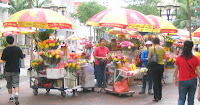Singapore – Asia for Wimps  While touring Ha Long Bay in Vietnam, we met a British family who had been Singapore residents for 12 years. They lovingly referred to Singapore as “Asia for wimps” or simply “Asia lite.” After our recent trip to Singapore we would agree. Unlike our Bangalore home, which we lovingly sometimes
While touring Ha Long Bay in Vietnam, we met a British family who had been Singapore residents for 12 years. They lovingly referred to Singapore as “Asia for wimps” or simply “Asia lite.” After our recent trip to Singapore we would agree. Unlike our Bangalore home, which we lovingly sometimes  call “planet chaos,” with its chaotic traffic, refuse clutter and swirling masses, Singapore is a gleaming, well-ordered city. With an orchid-filled airport, sleek subway system, orderly traffic flow, immaculately clean streets and upscale shopping malls we were far from the Asia we call home.
call “planet chaos,” with its chaotic traffic, refuse clutter and swirling masses, Singapore is a gleaming, well-ordered city. With an orchid-filled airport, sleek subway system, orderly traffic flow, immaculately clean streets and upscale shopping malls we were far from the Asia we call home.
Singapore, at the southern tip of the Malay Peninsula, is a teeming small island state of 267 sq miles with a population of 4.5 million. For comparison, the state of Rhode Island is 1,200 sq miles and has a population of 1 million. The ancient history of Singapore is sketchy. Third century Chinese writings refer to Singapore as Pu-luo-chung (island at the end of a peninsula). In the 1300’s, Javanese accounts speak of the Chinese community at Temasek, Sea Town. By the close of the 14th century, the Sanskrit name, Singapura (Lion City) was in common usage when referring to this island trading outpost.
the Chinese community at Temasek, Sea Town. By the close of the 14th century, the Sanskrit name, Singapura (Lion City) was in common usage when referring to this island trading outpost.
 With its strategic location in the southern end of the Straits of Malacca, Singapore was a prized possession for warring Malay, Javanese and Thai factions until the early 17th century. When Sir Stamford Raffles founded Singapore in 1819 for the British East Indian Company, Singapore became a gem in the “empire” upon which the sun never set.
With its strategic location in the southern end of the Straits of Malacca, Singapore was a prized possession for warring Malay, Javanese and Thai factions until the early 17th century. When Sir Stamford Raffles founded Singapore in 1819 for the British East Indian Company, Singapore became a gem in the “empire” upon which the sun never set.
With the confluence of oceanic steam travel and the opening of the Suez Canal in 1869, Singapore became a major coaling station and port of call along the European – East Asian travel routes. By the mid 19th century Singapore had a population of 80,000, of which nearly 2/3 was Chinese, with smaller populations of Malay, Indians and European.
 The historic influence of the Chinese culture is evident today. The population continues to be mainly Chinese, though English is the language in the city. Chinese and Malaysia signage and announcements are common in public places, however. The cuisine of the city is Asian and international. Dishes of noodle and duck vie for buyer attention along with Malay
The historic influence of the Chinese culture is evident today. The population continues to be mainly Chinese, though English is the language in the city. Chinese and Malaysia signage and announcements are common in public places, however. The cuisine of the city is Asian and international. Dishes of noodle and duck vie for buyer attention along with Malay  dishes of mee goreng (fried noodles) and menus from Burger King and Starbucks. The foundation of Chinese cooking is unmistakable. Where but Singapore can you can sit in an air- conditioned food mall and order from the Pig Organ Soup eatery?
dishes of mee goreng (fried noodles) and menus from Burger King and Starbucks. The foundation of Chinese cooking is unmistakable. Where but Singapore can you can sit in an air- conditioned food mall and order from the Pig Organ Soup eatery?
 Singapore appears peacefully at ease with its British history as well. The Raffles Hotel, in the old colonial district, is the premier prestige hotel in town. We stayed across the street at the more modern high-rise, Raffles the Plaza. The orderliness of centuries of Chinese culture and impeccable British etiquette has fused to form a land where littering and jaywalking are almost unknown. At intersections, people wait with resigned patience for the crossing signal to
Singapore appears peacefully at ease with its British history as well. The Raffles Hotel, in the old colonial district, is the premier prestige hotel in town. We stayed across the street at the more modern high-rise, Raffles the Plaza. The orderliness of centuries of Chinese culture and impeccable British etiquette has fused to form a land where littering and jaywalking are almost unknown. At intersections, people wait with resigned patience for the crossing signal to  change to green…even if the street is void of any traffic! Queuing is common. Commerce fills the streets. Shopping malls on Orchard Road and elsewhere are overflowing
change to green…even if the street is void of any traffic! Queuing is common. Commerce fills the streets. Shopping malls on Orchard Road and elsewhere are overflowing  with global goods.
with global goods.  Among the western-like restaurants and boutiques, we found temples (both Buddhist and Hindu) and decidedly Asian street theater that provided the tug to remind us that we were still very far from home.
Among the western-like restaurants and boutiques, we found temples (both Buddhist and Hindu) and decidedly Asian street theater that provided the tug to remind us that we were still very far from home.




















0 Comments:
Post a Comment
<< Home